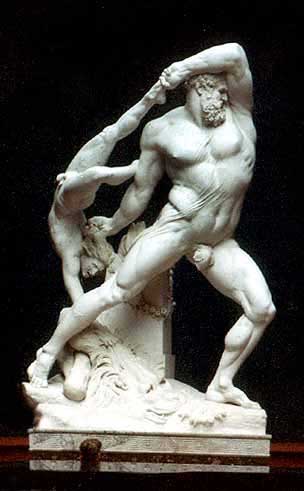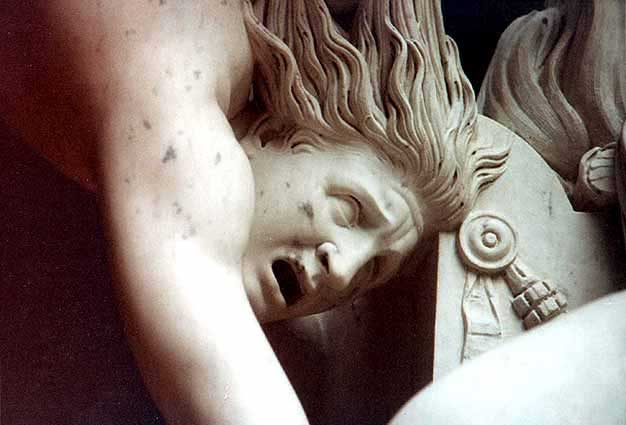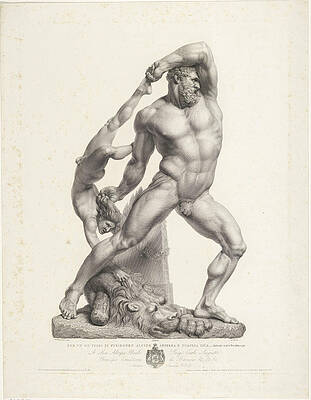.



Heracles and Lichas, Antonio Canova 1796. Heracles angry throws Lichas into the sea., Detail of Lichas
Hercules and Lichas, Giovanni Folo
In Greek mythology, Lichas (Λίχας) was Heracles' servant. He brought the shirt poisoned by Nessus from Deianira to Heracles, killing him.
The Lichades —three small islands between Euboea and Locris—were believed to have derived their name from him
Apollodorus , Library and Epitome :
Intending to offer sacrifice, he (Heracles) sent the herald Lichas to Trachis to fetch fine raiment. From him Deianira learned about Iole, and fearing that Heracles might love that damsel more than herself, she supposed that the spilt blood of Nessus was in truth a love-charm, and with it she smeared the tunic. So Hercules put it on and proceeded to offer sacrifice. But no sooner was the tunic warmed than the poison of the hydra began to corrode his skin; and on that he lifted Lichas by the feet, hurled him down from the headland, and tore off the tunic, which clung to his body, so that his flesh was torn away with it.
Ovid IX, 211.
Lichas is also a Spartan who discovered the bones of Orestes. The remains of Orestes were required, occording to a Delphic Oracle, in order for Sparta to defeat Tegea. Herodotus The History 1.68.
"
evel and smooth is the plain where Arcadian Tegea standeth;
There two winds are ever, by strong necessity, blowing,
Counter-stroke answers stroke, and evil lies upon evil.
There all-teeming Earth doth harbour the son of Atrides;
Bring thou him to thy city, and then be Tegea’s master.
After this reply, the Lacedaemonians were no nearer discovering the burial-place than before, though they continued to search for it diligently; until at last a man named Lichas, one of the Spartans called Agathoergi, found it. The Agathoergi are citizens who have just served their time among the knights. The five eldest of the knights go out every year, and are bound during the year after their discharge to go wherever the State sends them, and actively employ themselves in its service.
Lichas was one of this body when, partly by good luck, partly by his own wisdom, he discovered the burial-place. Intercourse between the two States existing just at this time, he went to Tegea, and, happening to enter into the workshop of a smith, he saw him forging some iron. As he stood marvelling at what he beheld, he was observed by the smith who, leaving off his work, went up to him and said,
“Certainly, then, you Spartan stranger, you would have been wonderfully surprised if you had seen what I have, since you make a marvel even of the working in iron. I wanted to make myself a well in this room, and began to dig it, when what think you? I came upon a coffin seven cubits long. I had never believed that men were taller in the olden times than they are now, so I opened the coffin. The body inside was of the same length: I measured it, and filled up the hole again.”
Such was the man’s account of what he had seen. The other, on turning the matter over in his mind, conjectured that this was the body of Orestes, of which the oracle had spoken....."
See also : Greek Mythology. Paintings, Drawings
| Ancient Greece
Science, Technology , Medicine , Warfare, , Biographies , Life , Cities/Places/Maps , Arts , Literature , Philosophy ,Olympics, Mythology , History , Images Medieval Greece / Byzantine Empire Science, Technology, Arts, , Warfare , Literature, Biographies, Icons, History Modern Greece Cities, Islands, Regions, Fauna/Flora ,Biographies , History , Warfare, Science/Technology, Literature, Music , Arts , Film/Actors , Sport , Fashion --- |
Retrieved from "http://en.wikipedia.org"
All text is available under the terms of the GNU Free Documentation License



